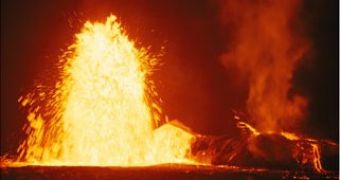Mauna Loa is one of the five volcanoes making up the Hawaii Island, the Earth's largest one, with a volume estimated at about 18,000 cubic miles (75,000 km?).
The way the massive volcano is bulging and the swelling could enable the researchers to forecast when the next massive eruption will occur. Better prognoses could save lives by helping officials to plan evacuations of residents living on the volcano's flanks.
A team led by Falk Amelung at the University of Miami employed satellite radar imagery to monitor two bulges on the flank of Mauna Loa for three years between 2002 and 2005. The team intended to explain the cause of the swelling, by using computer models of the volcano.
Being a shield volcano, Mauna Loa blasts rather from rifts in its flanks than through a top crater. This volcano possesses two long fractures in its crust, extending from the summit around the south-west rift zone, and this is the place from where magma flows during eruptions.
The bulges have been increasing since May 2002 and now they have reached 15 km (9 mi) in diameter being 20 cm (0.6 ft) high. The computer model showed that the only way to reverse the swelling was if magma moved to the southwest rift zone. It seems that a 1983 earthquake and a 1984 eruption cleansed the rift zone, making this possible. "We now have a good idea where the next eruption is most likely to occur," said Amelung.
The pressure of the magma could first trigger an earthquake, before the eruption.
The team was not able to forecast the date of the next eruption and the force exerted by the magma into the rift zone has largely decreased since 2006. "It is now about one-quarter to one-third of what we had between 2002 and 2005, so we have no indication that it will erupt anytime soon," Amelung told New Scientist. "The technique could be used to monitor and forecast eruptions on other large shield volcanoes, such as Mount Etna in Italy, Piton de la Fournaise on the Reunion island, and Kilauea in Hawaii", he added.

 14 DAY TRIAL //
14 DAY TRIAL //